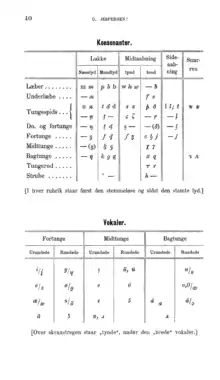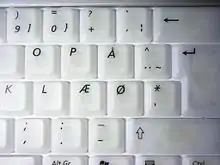Dania transcription
Dania (Latin for Denmark) is the traditional linguistic transcription system used in Denmark to describe the Danish language. It was invented by Danish linguist Otto Jespersen and published in 1890 in the Dania, Tidsskrift for folkemål og folkeminder magazine from which the system was named.

Jespersen's Dania system differs from the later IPA, particularly concerning the Danish vowel letters. There is no official moderation of the standard and so specific phonetic symbols may differ from author to author. Also, there are no absolute phonetic references for the standard and so its usage is discouraged by Danish phoneticians and phonologists.
Consonant chart
| Bilabial | Labio- dental |
Dental | Alveolar | Palatalized | Post-alveolar | Palatal | Velar | Uvular | Glottal | ||||||||||||||||||||
|---|---|---|---|---|---|---|---|---|---|---|---|---|---|---|---|---|---|---|---|---|---|---|---|---|---|---|---|---|---|
| Nasal | m | hm | m | ʍ | n | hn | n | ṇ | ᶇ | ꬼ | ꬼ̣ | ƞ | |||||||||||||||||
| Stop | p | b | b | t | d | d | ṭ | ḍ | ƫ (τ [tˢʰ]) | ᶁ | ȶ* | ȡ* | ᶄ* | ꬶ | k | g (gᷱ [kʷ]) | g | (gᷱ) | ʼ | ||||||||||
| Fricative/ approximant |
w | ƕ | w | s | z | ς | ζ | ᶊ | ʃ | ʓ | |||||||||||||||||||
| ƀ | f | v | v | þ | ð | ð | ˜ṛ 2 | ṛ | δ | c | ꜧ | j | χ | ɣ | x | q | q 3 | ˜r 2 | hr | r | h | ||||||||
| Lateral | l | hl | l | ḷ | ᶅ | ȴ* | (ł) | ||||||||||||||||||||||
| Trill | pʳ | ˜ʀ 2 | ʀ | ꭋ | ˏꭋ 2 | ɹ˷ 2 | ɹ [ɐ̯] | ||||||||||||||||||||||
- *These letter shapes are approximations. In Jespersen the loop goes the other way or (with ᶄ) crosses back over the leg of the letter. (See the image at the top of this page.)
- 2 The swash joins to these letters as an arm to the left.
- 3 Or perhaps ɋ.[3]
For mixed voicing, one normally writes (e.g. for voiced m) mh for final voicelessness and hm for initial voicelessness, with roman-type m for fully voiceless [m̥]. But there are two ligatures: hw > ƕ and hj > ꜧ. Roman-type b, d etc. are fully voiced, sounds which occur in dialects such as Bornholmsk. Note that roman typeface indicates a modally voiced sound with plosives, a voiceless sound with sonorants and laterals, and a partially voiceless sound with fricatives/approximants.
Vowel chart
A slash separates 'thin/narrow' from 'wide' vowels. A mid dot may be added for length. The comma for stød combines with this to form the 'comma-punkt'.
| Front | Central | Back | ||||
|---|---|---|---|---|---|---|
| unrounded | rounded | unrounded | rounded | unrounded | rounded | |
| High | i [i] | y [y], ü [ʉ̟]3 | ı̣ [ɨ] | u̇ [ʉ]3 | u [u] | |
| Near high | ꞁ̇ [ɪ] | ɥ [ʏ] | ȣ [ʊ] | |||
| High-mid* | e [e] (ė [e̞]) | ø [ø] (ø̇ [ø̞]) |
ə [ɘ] | ȯ [ɵ] | o [o] (0 [o̞]) | |
| Mid | ɛ [ɛ̝] | o̤ [œ̝] | ꜵ [ɔ̝] | |||
| Low-mid | œ [ɛ] | ꝋ [œ] | ɜ [ɜ] | ɔ̇ [ɞ] | ɑ [ʌ] | ɑ̊ [ɔ] |
| Near-low | æ 1 [ɛ̞] | ö [œ̞] | ɒ̤ [ɐ̟], ɒ [ɐ] | |||
| Low | ɑ̈ [æ] | ɔ̈ [ɶ] | ɑ̇ [a] | a 2 [ɑ] | ɔ [ɒ] | |
* Mid ė, ø̇, 0 are weak allophones of e, ø, o.
See also
References
- Otto Jespersen, Dania Lydskrift, in Dania, Tidsskrift for folkemål og folkeminder -- 1890-1892, vol. 1, p. 40
- Marius Kristensen, 1924, Vejledning til brugen af Danias lydskrift, p. 28.
- The contrast between italic ⟨q⟩ and italic ⟨ɋ⟩ in the chart at the end of Kristensen (1924) appears to be a typo. In the index and in the description in the text the contrast is instead between roman ⟨q⟩ and italic ⟨q⟩ (or ⟨ɋ⟩).
